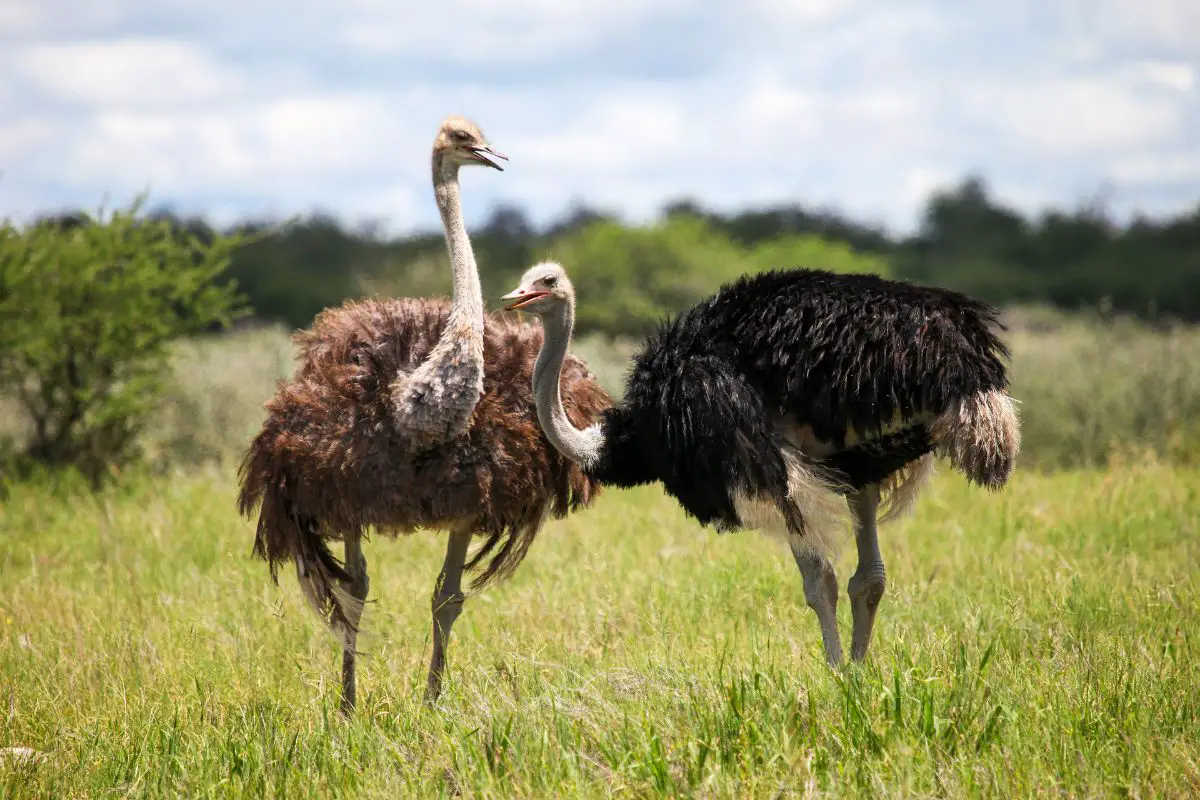
There are many different kinds of birds in the world. Some of them, like ostriches, have some features that are similar to each other. If you’re interested in learning more about these types of birds, keep reading! Ostriches are interesting creatures with a lot to offer, and they can be fun to learn about.
What is an ostrich?
The ostrich is a large, flightless bird that is native to Africa. Ostriches are the largest living species of bird, and they are also the fastest running land animals on Earth. They can reach speeds of up to 45 miles per hour!
Ostriches are known for their long necks and legs, and they can grow to be up to 9 feet tall, and they weigh around 200 pounds! Ostriches are flightless birds. They use their long legs to run quickly, and they can also use their powerful legs to kick predators.
What does an ostrich look like?
Ostriches have long necks and legs, and they are covered in feathers. The feathers of an ostrich are black, with white stripes on the wings. The plumage of the male is predominantly black, with white wings and tail feathers, while the female’s plumage is a more muted gray-brown.
Both sexes have bare, pinkish-gray skin on their heads and necks. Ostriches also have two toes on each foot, and they use their toes to grip the ground while they are running.
What do ostriches eat?
Ostriches are omnivorous, which means that they eat both plants and animals. Ostriches typically eat seeds, fruits, and leaves, but they will also eat insects, lizards, and small mammals.
An ostrich’s diet consists mostly of plants, though they will also eat insects and small animals. They are able to digest plant matter that other animals cannot due to special bacteria in their digestive system.
Where do ostriches live?
Ostriches are found in Africa, specifically in the countries of Ethiopia, Kenya, Somalia, and South Africa.
What is the lifespan of an ostrich?
The average lifespan of an ostrich is between 30 and 40 years.
What is the habitat of an ostrich?
Ostriches live in open habitats, such as savannas, woodlands, and grasslands.
What are an ostrich’s identifying features and behaviors?
Ostriches are fast runners and can reach speeds of up to 45 miles per hour. They are also excellent swimmers. When threatened, they will sometimes lie flat on the ground, with their necks extended, in an attempt to blend in with their surroundings and avoid being seen.
Ostriches are social birds and live in small groups called flocks. The largest flock ever recorded contained over 1,000 birds. These flocks typically consist of a mix of males, females, and juveniles.
Now that you know all the most important facts about ostriches, here are 20 other birds that share some similarities with ostriches.
1. Emu
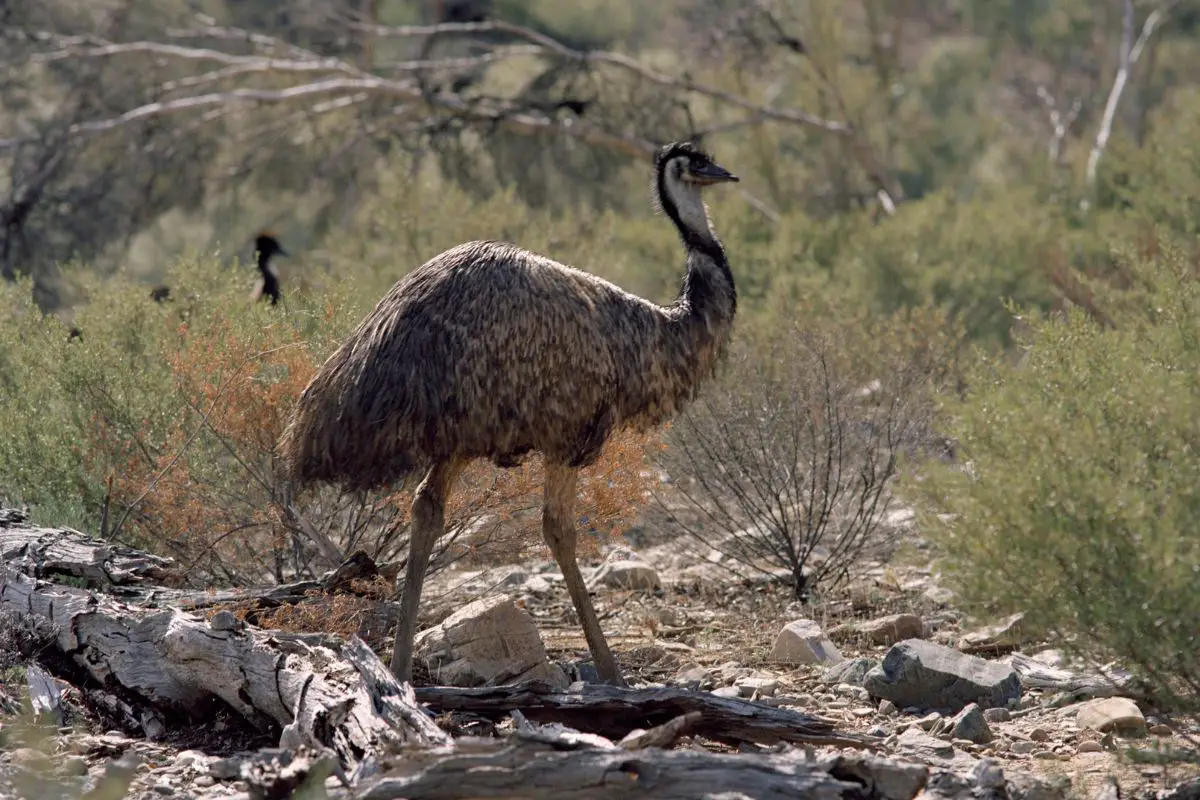
The Emu is a flightless bird found in Australia and New Guinea. It is the second-largest living bird by height, after its relative, the ostrich. They have long necks and legs and can run at speeds of up to 50 kilometers per hour (31 mph).
How big it gets?
Emus can reach up to 1.9 meters (6.2 ft) in height and weigh as much as 90 kilograms (200 lb).
What it looks like?
Emus have grey-brown plumage and long, strong legs. Females are usually slightly larger than males. They have small heads and long necks and can live for up to 20 years in the wild.
Where it lives?
The Emu is found in Australia and New Guinea. It prefers open woodlands and grasslands.
What it eats?
The Emu is a herbivore, and its diet consists of fruits, leaves, seeds, and insects.
How long does it live?
The Emu can live for up to 20 years in the wild.
Behaviors
The Emu is a nomadic bird and will travel long distances in search of food and water. It is also a very social bird and can often be seen in groups of up to 100 individuals. The Emu is a very curious bird and is known to approach humans and other animals in a curious, non-threatening manner.
The Emu is also known to be a very good swimmer and can often be seen swimming in the ocean.
Similarities to ostriches
The Emu is a flightless bird that is closely related to the ostrich. It shares many of the same physical features, such as its long neck and legs, and can reach similar speeds when running. The Emu is also a social bird that lives in flocks and is known to be curious and approach humans in a non-threatening way.
Emus are also known for their powerful legs, which they use to kick predators.
Differences from ostriches
The Emu is smaller than the ostrich, and its plumage is grey-brown instead of black. Emus also have small heads and long necks, while ostriches have large heads and short necks. Emus live in Australia and New Guinea, while ostriches are found in Africa.
Finally, Emus are known to be good swimmers, while ostriches are not.
Fun facts
-The Emu is the national bird of Australia and is featured on a special Australian $1 coin.
2. Rhea
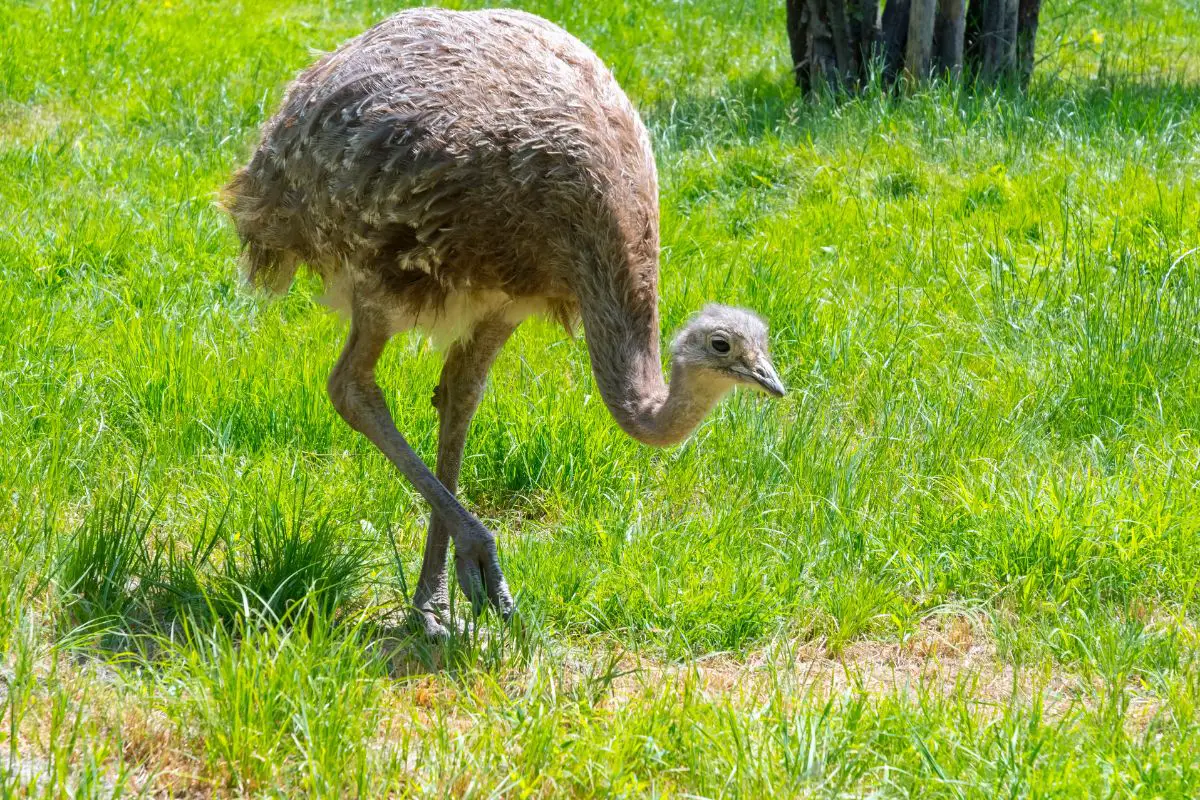
The rhea is a bird that is native to South America. It is the largest bird in South America, and it is the third-largest bird in the world, after the ostrich and the Emu. Like ostriches, rheas are flightless birds.
They have two toes on each foot, and they use their long legs to run quickly.
How big it gets?
Rheas can grow to be about 5 feet tall, and they weigh around 90 pounds.
What it looks like?
Rheas are gray or brown birds with long necks and legs. They have two toes on each foot, and their plumage is often lighter on the underside.
Where it lives?
Rheas are found in South America, in countries such as Argentina, Bolivia, Brazil, and Paraguay.
What it eats?
Rheas are omnivores, and their diet consists of plants, fruits, seeds, insects, and small animals.
How long does it live?
Rheas can live for up to 20 years in the wild.
Behaviors
Rheas are social birds, and they live in groups of up to 40 individuals. These groups are called “herds.” Rheas are also nomadic birds, and they travel long distances in search of food and water.
Rheas are known to be curious birds, and they often approach humans and other animals in a curious, non-threatening manner.
Similarities to ostriches
Rheas are flightless birds that are closely related to the ostrich. They share many of the same physical features, such as their long necks and legs, and can reach similar speeds when running. Rheas are also social birds that live in herds and are known to be curious and approach humans in a non-threatening way.
Rheas are also known for their powerful legs, which they use to kick predators.
Differences from ostriches
Rheas are smaller than ostriches, and their plumage is often lighter on the underside. Rheas are found in South America, while ostriches are found in Africa.
Fun facts
- Rheas can lay up to 3 clutches of eggs per year.
- Rhea eggs are the largest bird eggs in the world.
- The rhea is the national bird of Argentina.
3. Cassowary
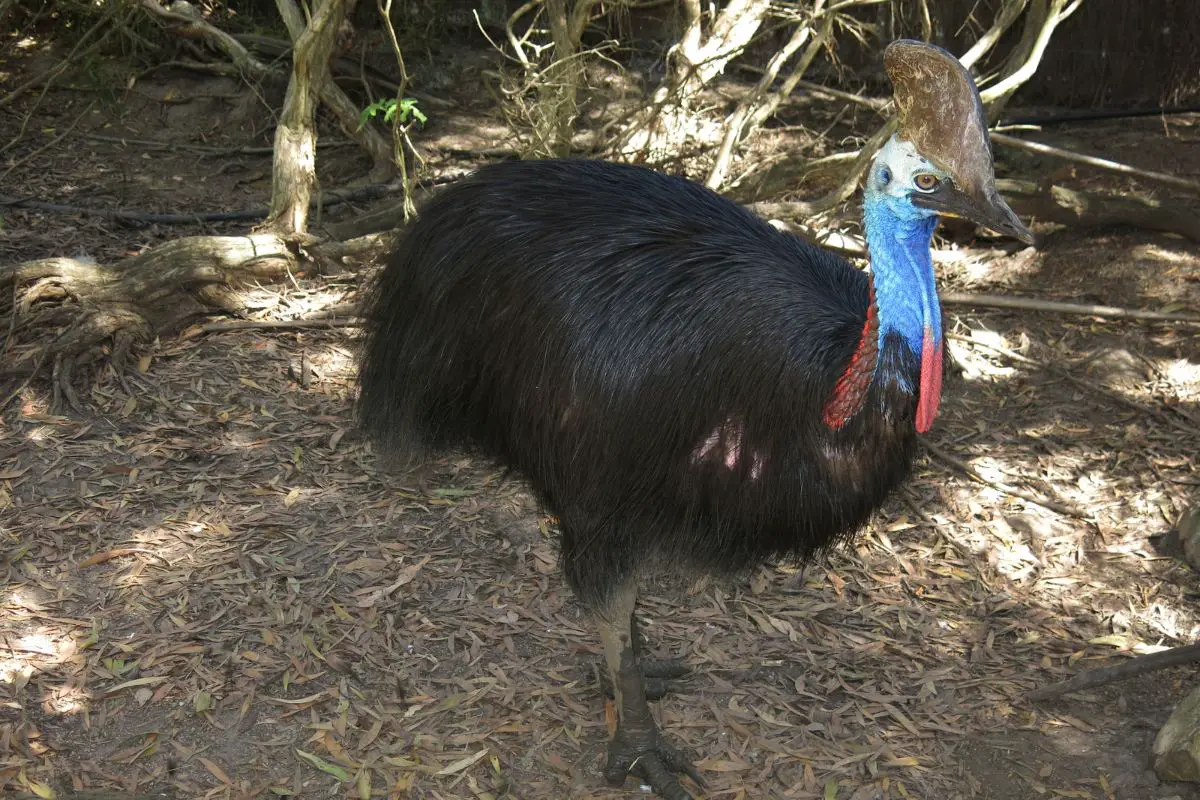
The Cassowary is a bird that is native to Australia and New Guinea. It is the second-largest bird in the world, after the ostrich. Like ostriches, cassowaries are flightless birds.
They have three toes on each foot, and they use their long, sharp claws to defend themselves. Cassowaries are shy birds, and they are not often seen in the wild.
How big it gets?
The Cassowary can grow up to 6 feet tall.
What it looks like?
The Cassowary has black feathers and a blue neck. It has a long, sharp beak, and it has three toes on each foot. There are ways to tell the difference between a male and a female bird.
For example, male birds usually have brighter feathers than female birds. Female birds also tend to be a bit smaller than male birds.
Where it lives?
Cassowaries live in the rainforests of Australia and New Guinea.
What it eats?
Cassowaries eat fruits, leaves, and insects. They also eat small animals, such as lizards and snakes.
How long does it live?
Cassowaries can live for up to 50 years.
Behaviors
Cassowaries are shy birds, and they are not often seen in the wild. When they are threatened, they will use their long, sharp claws to defend themselves. Cassowaries are also good swimmers, and they can run very fast.
Similarities to ostriches
Both cassowaries and ostriches are flightless birds.
Differences from ostriches
Cassowaries are shy birds, and they are not often seen in the wild, while ostriches are frequently seen in the wild.
Fun facts
- Cassowaries are sometimes called “rainforest ponies” because they look like small horses.
- Cassowaries can run up to 30 miles per hour.
- The Cassowary is the national bird of Papua New Guinea.
4. Kiwi
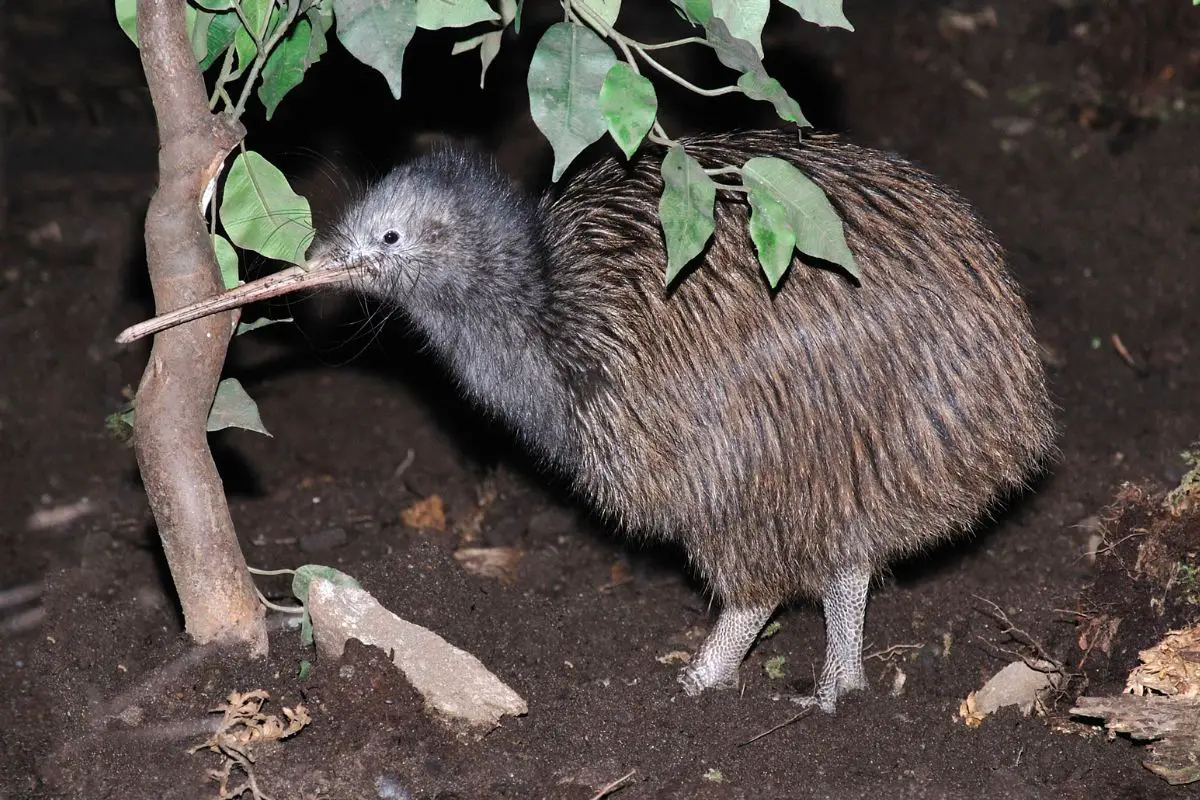
The kiwi is a bird that is native to New Zealand. It is the smallest bird in the world, and it is the only bird that has nostrils at the end of its beak. The kiwi is a nocturnal bird, and it is the only bird that has feathers that are all the same length.
The kiwi is a very shy bird, and it is very difficult to see in the wild.
How big it gets?
Kiwis can grow to be about 2 feet tall, and they weigh around 4 pounds.
What it looks like?
Kiwis have brown feathers and a long, curved beak. They have small wings, and they cannot fly. Kiwis also have three toes on each foot instead of the usual four.
Where it lives?
Kiwis live in the forests and mountains of New Zealand.
What it eats?
Kiwis eat insects, worms, and small animals. They also eat fruits and berries.
How long does it live?
Kiwis can live for up to 20 years in the wild.
Behaviors
Kiwis are nocturnal birds, and they are very shy. They are also very good at camouflage, and they are difficult to see in the wild. Kiwis are also good swimmers, and they can run very fast.
Similarities to ostriches
Both kiwis and ostriches are flightless birds. They both have two toes on each foot instead of the usual three.
Differences from ostriches
Kiwis are the smallest birds in the world, while ostriches are the largest. Kiwis are nocturnal birds, while ostriches are not.
Fun facts
- Kiwis are also known as “national icons” in New Zealand.
- The kiwi is the national bird of New Zealand.
5. Penguin
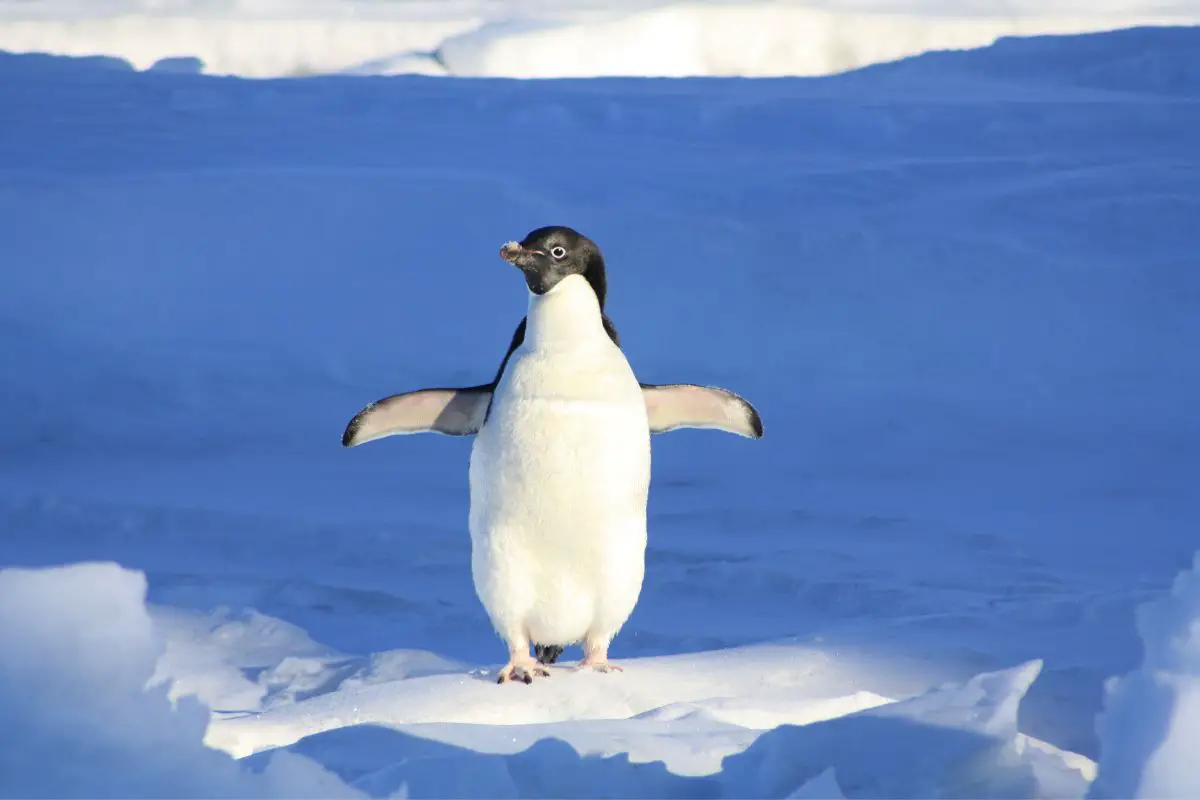
Penguins are birds that are native to the southern hemisphere. There are many different kinds of penguins, and they come in many different sizes. Penguins are flightless birds.
They have wings, but they use them to swim underwater. Penguins use their long legs to walk on land, and they use their flippers to swim.
How big it gets?
The largest penguin is the emperor penguin, which can grow to be about 4 feet tall and weigh around 90 pounds. Other species of penguin are significantly smaller, the smallest being the fairy penguin which only grows to be about 10 inches tall and weighs around 2 pounds.
What it looks like?
Penguins are black and white birds. They have a long beak, and they have feathers that cover their entire body. Penguins also have webbed feet, which helps them to swim.
Where it lives?
Penguins live in the southern hemisphere. They live in Antarctica, as well as in countries such as Chile, Argentina, and Australia.
What it eats?
Penguins eat fish, squid, and other marine animals.
How long does it live?
Penguins can live for up to 20 years in the wild.
Behaviors
Penguins are very good swimmers, and they can swim up to 25 miles per hour. Penguins are also social birds, and they live in large groups called colonies.
Similarities to ostriches
Both penguins and ostriches are flightless birds.
Differences from ostriches
Penguins are much smaller than ostriches.
Fun facts
- Penguins are sometimes called “birds of the sea” because they spend so much time in the water.
- Penguins are also known for their waddling walk.
6. Dalmatian Pelicans
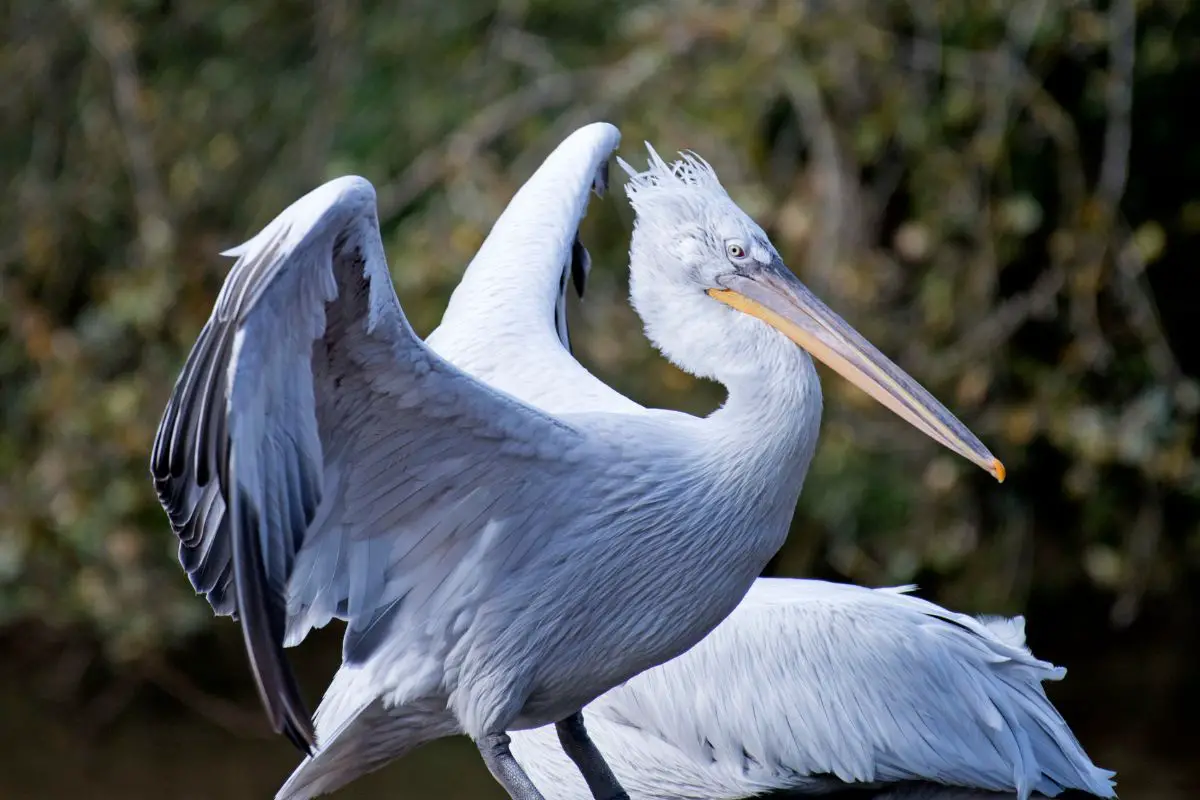
Dalmatian pelicans are a type of pelican that is found in Europe and Africa. They are the largest type of pelican. Dalmatian pelicans have a white body with black spots. They have a long neck and a large, pouch-like beak.
Dalmatian pelicans are very good at swimming, and they use their large beaks to scoop up fish from the water.
How big it gets?
Dalmatian pelicans can grow to be up to 10 feet tall and weigh up to 30 pounds.
What it looks like?
Dalmatian pelicans have a white body with black spots. They have a long neck and a large, pouch-like beak.
Where it lives?
Dalmatian pelicans live in Europe and Africa. They are found near lakes, rivers, and marshes.
What it eats?
Dalmatian pelicans eat fish, crustaceans, and other aquatic animals. They use their large beaks to scoop up their food from the water.
How long does it live?
Dalmatian pelicans can live for up to 20 years in the wild.
Behaviors
Dalmatian pelicans are very social birds, and they live in large groups. They are also very good swimmers, and they use their large beaks to scoop up fish from the water.
Similarities to ostriches
Both dalmatian pelicans and ostriches have long necks and long legs.
Differences from ostriches
Dalmatian pelicans are much smaller than ostriches. Dalmatian pelicans have a white body with black spots, while ostriches are mostly brown. Dalmatian pelicans live in Europe and Africa, while ostriches are native to Africa only.
Fun facts
- Dalmatian pelicans are the largest type of pelican.
- Dalmatian pelicans get their name from the Dalmatian Coast in Croatia, where they were first discovered.
7. Andean Condor
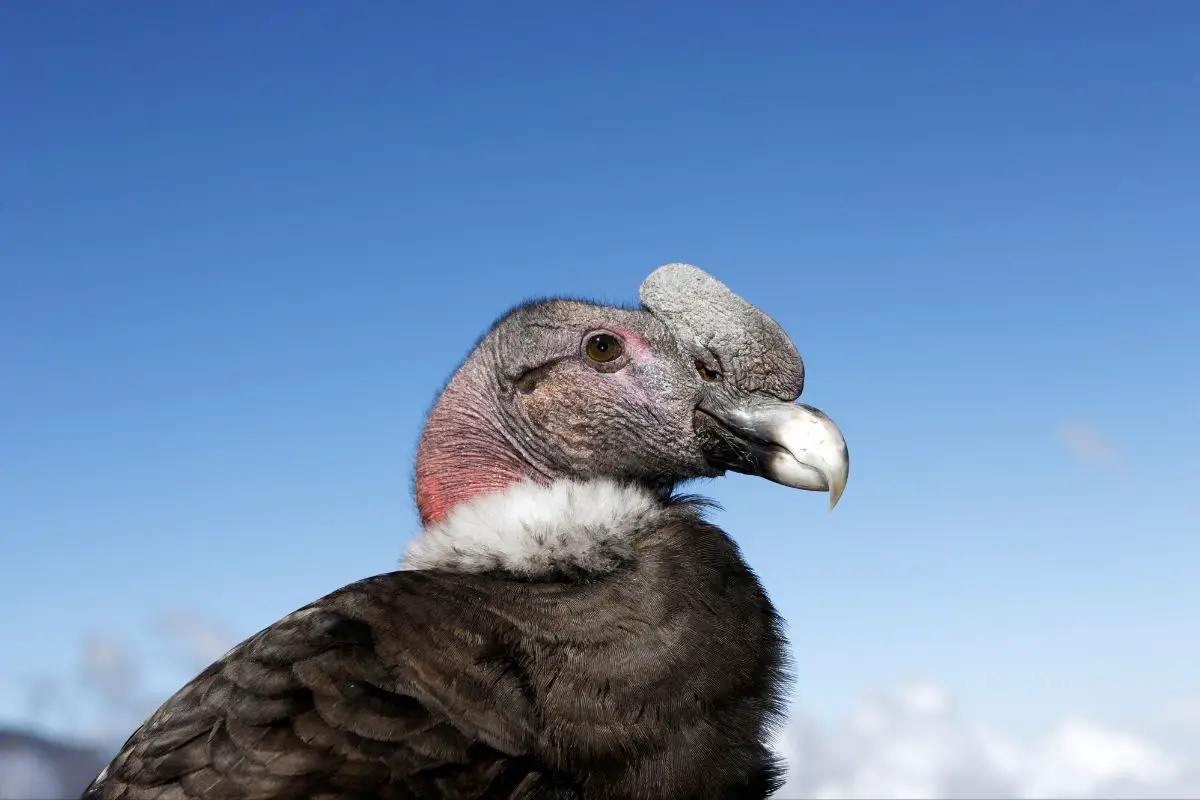
The Andean condor is a large bird that is found in the mountains of South America. Andean condors have black feathers and a white patch on their chest. Andean condors have a wingspan of up to 10 feet, and they weigh up to 30 pounds.
Andean condors live in caves or on cliffs, and they eat carrion.
How big it gets?
Andean condors can grow to be up to 10 feet tall and weigh up to 30 pounds.
What it looks like?
Andean condors have black feathers and a white patch on their chest. They have a wingspan of up to 10 feet.
Where it lives?
Andean condors live in the mountains of South America. They are found in countries such as Peru, Ecuador, and Chile.
What it eats?
Andean condors eat carrion, which is the flesh of dead animals.
How long does it live?
Andean condors can live for up to 50 years in the wild.
Behaviors
Andean condors are scavengers, and they eat the flesh of dead animals. Andean condors are also very social birds, and they live in large groups.
Similarities to ostriches
Both Andean condors and ostriches have long necks and long legs. Andean condors and ostriches are also both scavengers.
Differences from ostriches
Andean condors are much smaller than ostriches. Andean condors have black feathers and a white patch on their chest, while ostriches are mostly brown. Andean condors live in the mountains of South America, while ostriches live in Afria.
Fun facts
- Andean condors are the largest land birds in the world.
- Andean condors can fly at speeds of up to 55 miles per hour.
8. Marabou Stork
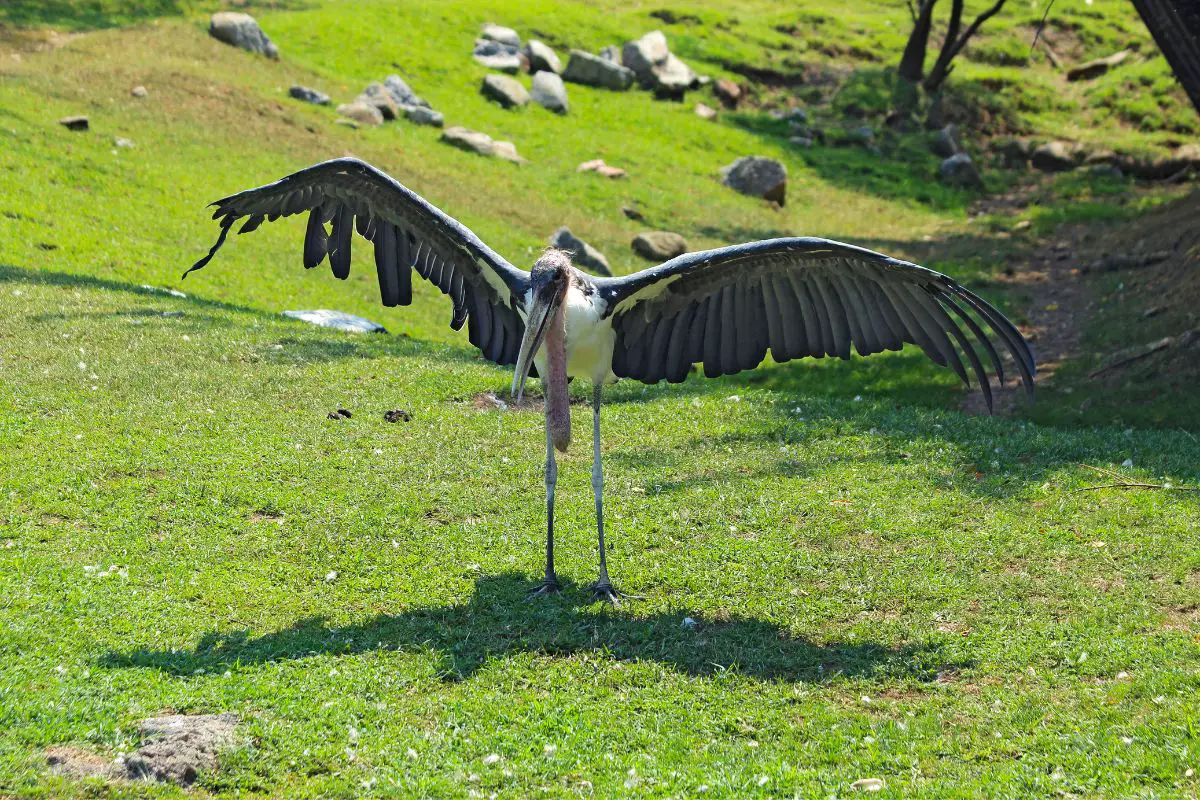
The marabou stork is a large bird that is found in Africa. Marabou storks have white feathers and long necks. They have a wingspan of up to 10 feet, and they weigh up to 15 pounds.
Marabou storks live near rivers and lakes, and they eat carrion.
How big it gets?
Marabou storks can grow to be up to 10 feet tall and weigh up to 15 pounds.
What it looks like?
Marabou storks have white feathers and long necks. They have a wingspan of up to 10 feet.
Where it lives?
Marabou storks live in Africa. They are found in countries such as Sudan, Kenya, and Uganda.
What it eats?
Marabou storks eat carrion, which is the flesh of dead animals.
How long does it live?
Marabou storks can live for up to 20 years in the wild.
Behaviors
Marabou storks are scavengers, and they eat the flesh of dead animals. Marabou storks are also very social birds, and they live in large groups.
Similarities to ostriches
Both marabou storks and ostriches have long necks and long legs. Marabou storks and ostriches are also both scavengers. They also both live in Africa.
Differences from ostriches
Marabou storks are much smaller than ostriches. Marabou storks have white feathers, while ostriches are mostly brown.
9. Trumpeter Swan
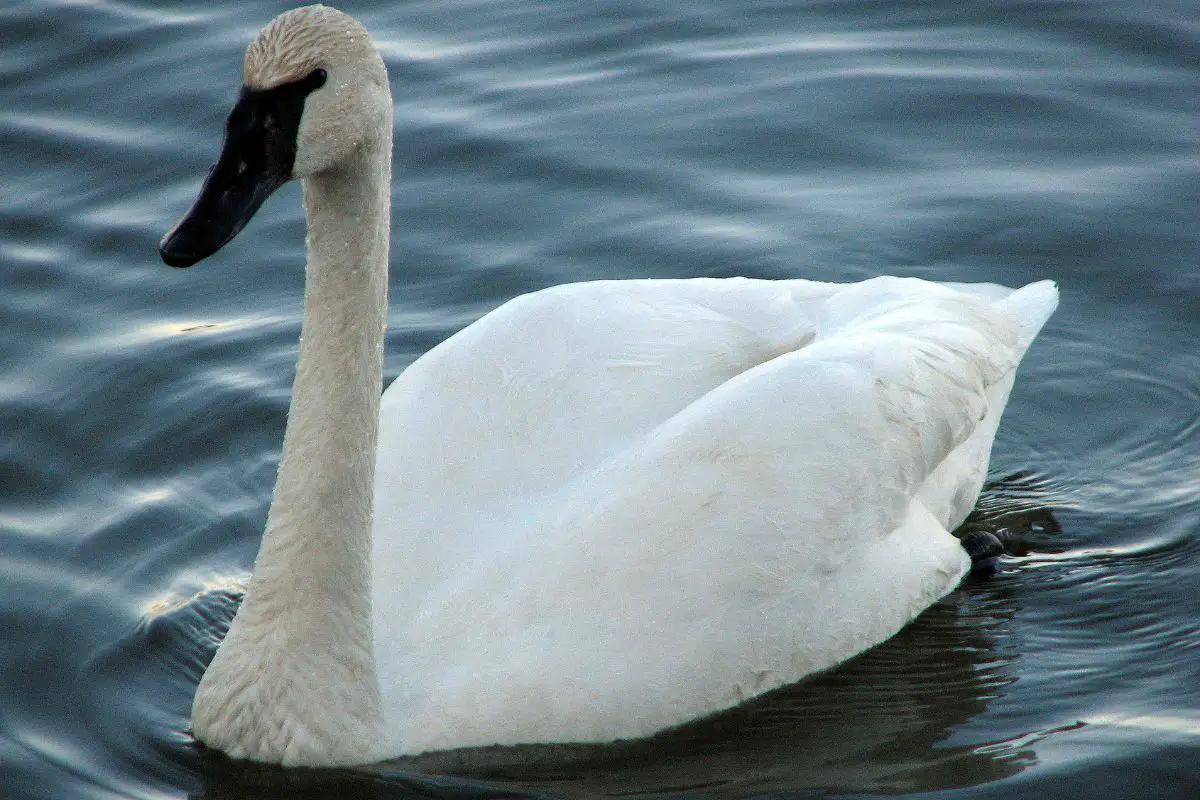
The trumpeter swan is a large bird that is found in North America. Trumpeter swans have white feathers and long necks. They have a wingspan of up to 10 feet, and they weigh up to 30 pounds.
Trumpeter swans live near rivers and lakes, and they eat aquatic plants.
How big it gets?
Trumpeter swans can grow to be up to 10 feet tall and weigh up to 30 pounds.
What it looks like?
Trumpeter swans have white feathers and long necks. They have a wingspan of up to 10 feet.
Where it lives?
Trumpeter swans live in North America. They are found in countries such as the United States, Canada, and Alaska.
What it eats?
Trumpeter swans eat aquatic plants.
How long does it live?
Trumpeter swans can live for up to 20 years in the wild.
Behaviors
Trumpeter swans are social birds, and they live in large groups. Trumpeter swans are also very protective of their young.
Similarities to ostriches
Both trumpeter swans and ostriches have long necks and long legs. Trumpeter swans and ostriches are also both social birds.
Differences from ostriches
Trumpeter swans are much smaller than ostriches. Trumpeter swans have white feathers, while ostriches are mostly brown. Trumpeter swans live in North America, while ostriches are indigenous to Africa.
Fun facts
- Trumpeter swans are the largest waterfowl in the world.
- Trumpeter swans can fly at speeds of up to 60 miles per hour.
10. Kori Bustard
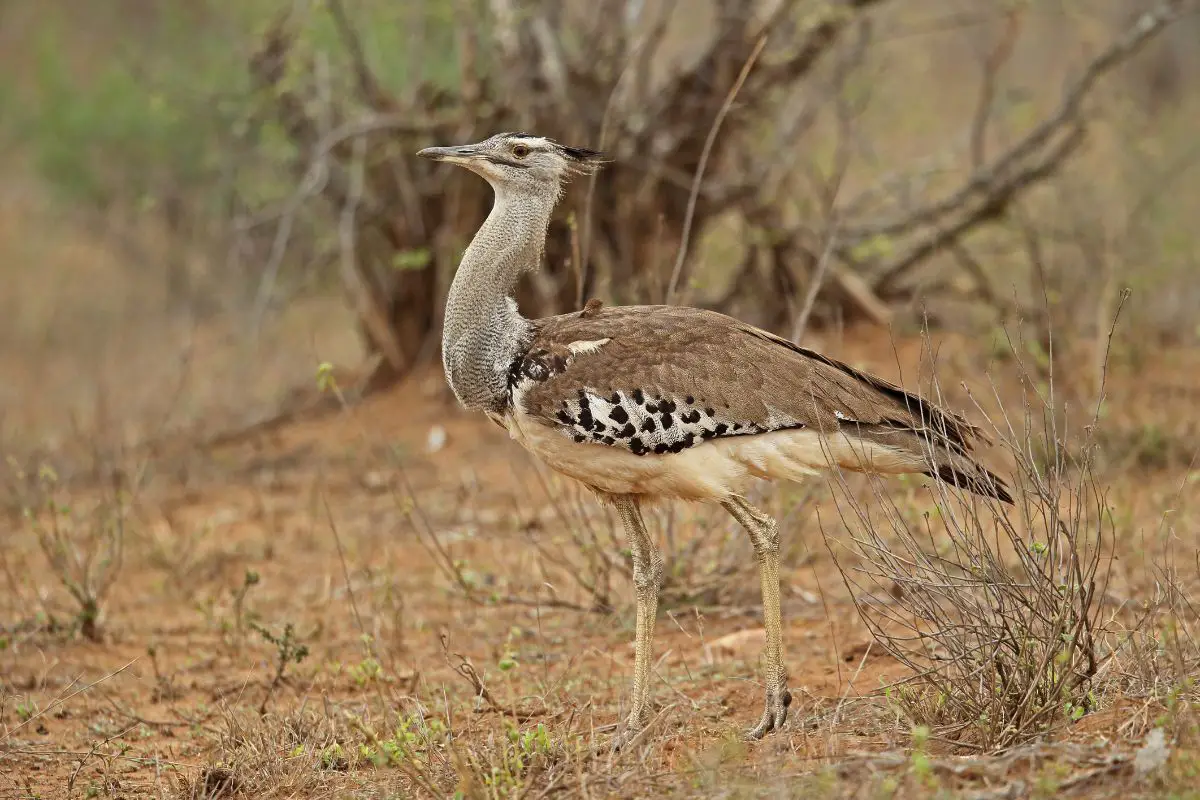
The kori bustard is a large bird that is found in Africa. Kori bustards have brown feathers and long necks. They have a wingspan of up to 10 feet, and they weigh up to 40 pounds.
Kori bustards live in grasslands, and they eat insects and small animals.
How big it gets?
Kori bustards can grow to be up to 10 feet tall and weigh up to 40 pounds.
What it looks like?
Kori bustards have brown feathers and long necks. They have a wingspan of up to 10 feet.
Where it lives?
Kori bustards live in Africa. They are found in countries such as Kenya, Tanzania, and South Africa.
What it eats?
Kori bustards eat insects and small animals.
How long does it live?
Kori bustards can live for up to 20 years in the wild.
Behaviors
Kori bustards are social birds, and they live in large groups. Kori bustards are also very protective of their young.
Similarities to ostriches
Both kori bustards and ostriches have long necks and long legs. Kori bustards and ostriches are also both social birds.
Differences from ostriches
Kori bustards are much smaller than ostriches.
Fun facts
- Kori bustards are the heaviest flying bird in the world.
- Kori bustards can fly at speeds of up to 40 miles per hour.
11. Greater Flamingo
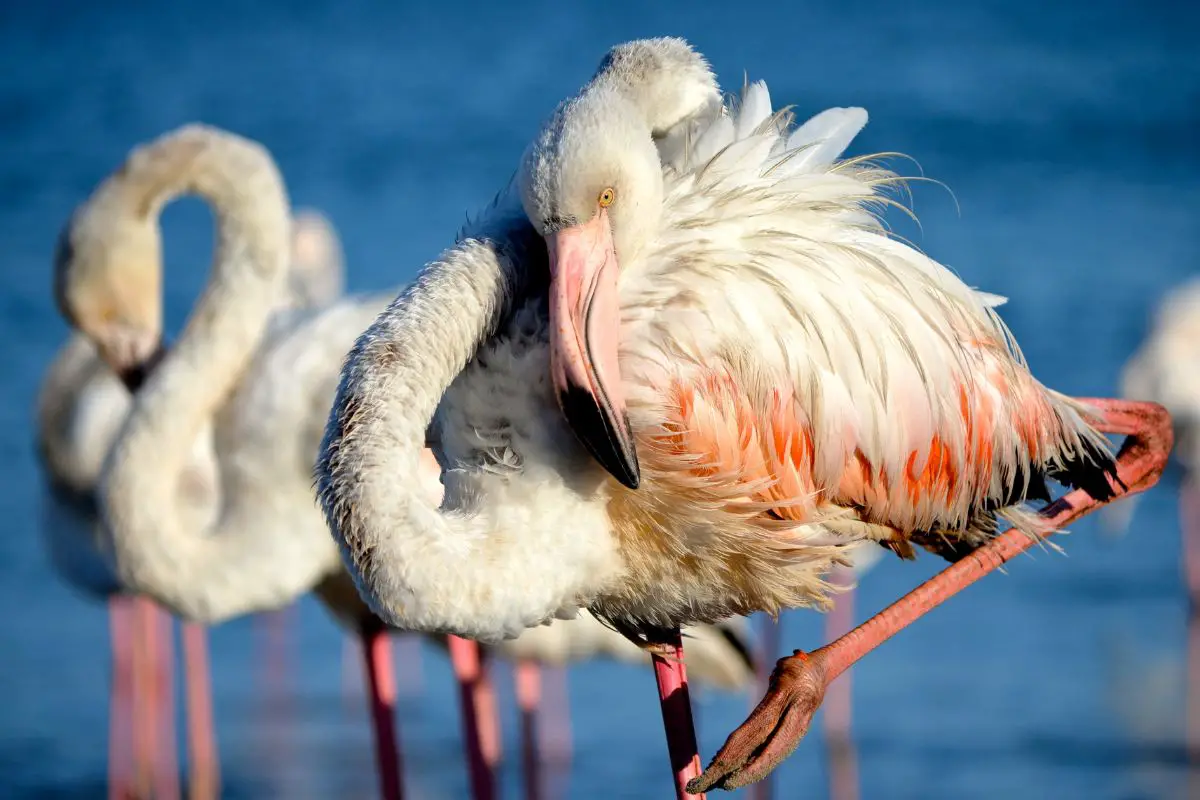
The greater flamingo is a large bird that is found in Africa, Europe, and Asia. Greater flamingos have pink feathers and long necks. They have a wingspan of up to 10 feet, and they weigh up to 8 pounds.
Greater flamingos live near rivers and lakes, and they eat shrimp and other small animals.
How big it gets
Greater flamingos can grow to be up to 10 feet tall and weigh up to 8 pounds.
What it looks like?
Greater flamingos have pink feathers and long necks. They have a wingspan of up to 10 feet.
Where it lives?
Greater flamingos live in Africa, Europe, and Asia. They are found in countries such as Egypt, Spain, and India.
What it eats?
Greater flamingos eat shrimp and other small animals.
How long does it live?
Greater flamingos can live for up to 40 years in the wild.
Behaviors
Greater flamingos are social birds, and they live in large groups. Greater flamingos are also very protective of their young.
Similarities to ostriches
Both greater flamingos and ostriches have long necks and long legs. Greater flamingos and ostriches are also both social birds.
Differences from ostriches
Greater flamingos are much smaller than ostriches. Greater flamingos have pink feathers, while ostriches are mostly brown.
Fun facts
- Greater flamingos are the tallest species of flamingo.
- Greater flamingos can fly at speeds of up to 30 miles per hour.
Frequently Asked Questions
How fast can an ostrich run?
Ostriches can reach speeds of up to 45 miles per hour.
How big are ostrich eggs?
Ostriches are the biggest living species of bird. They weigh between 220 and 280 pounds and can reach up to 9 feet in height. Ostrich eggs are the largest eggs in the world, measuring up to 6 inches long and 5 inches wide.
They can weigh up to 3 pounds.
What is the lifespan of an ostrich?
Ostriches can live up to 40 or 50 years in the wild and up to 60 years in captivity.
What is the scientific name for an ostrich?
The scientific name for an ostrich is Struthio camelus.



